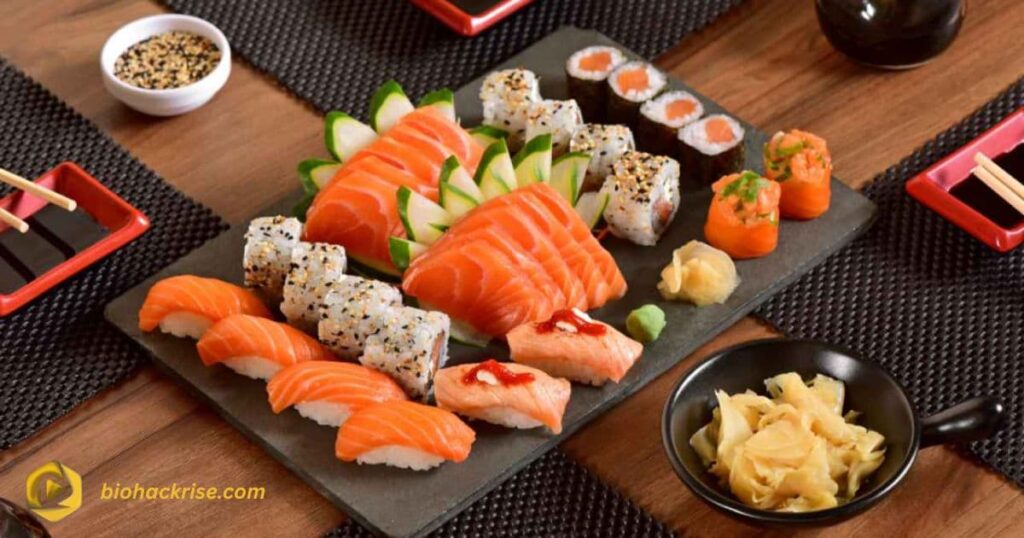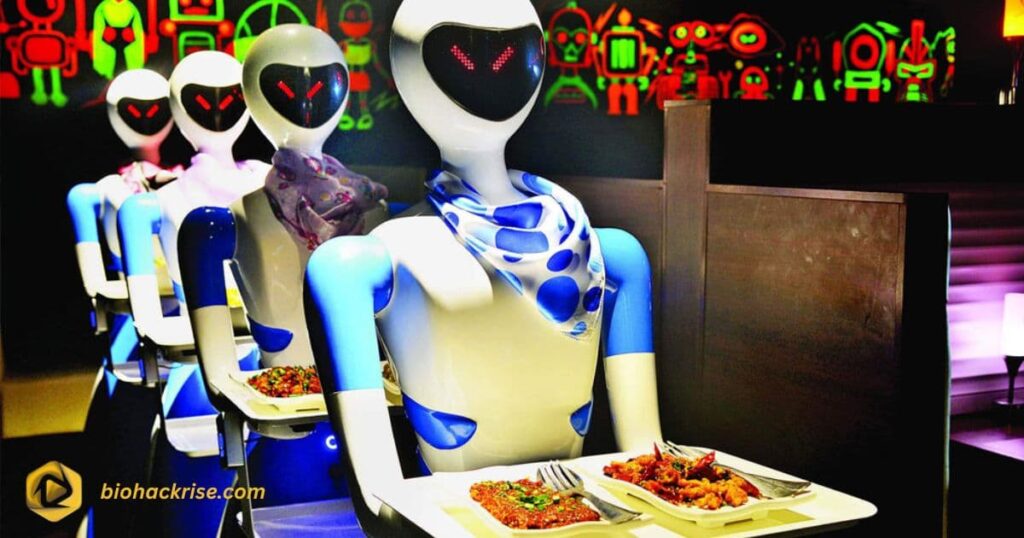Sushi AI Menu: Future of Dining with Artificial Intelligence
Artificial Intelligence (AI) has transformed almost every industry imaginable, and the food sector is no exception. Among the latest innovations taking the culinary world by storm is the Sushi AI Menu a technology-driven approach that’s reshaping how people order, experience and enjoy sushi. From AI-powered recommendations to robotic chefs crafting rolls with precision, the Sushi AI Menu isn’t just a trend it’s the future of modern dining.
In this blog post, we’ll dive deep into how this innovative system works, what makes it unique, and why it’s becoming the gold standard for tech-savvy sushi lovers worldwide.
What Is a Sushi AI Menu?
At its core, a Sushi AI Menu is an intelligent digital system that uses artificial intelligence to enhance the sushi dining experience. Unlike traditional paper menus, this smart menu interacts with customers in real time, learning their taste preferences, dietary restrictions, and even mood patterns to suggest the perfect sushi combination.
Imagine walking into a sushi restaurant and being greeted by a digital assistant that already knows your favorite roll, spice level, and even whether you prefer soy sauce or wasabi on the side. That’s the magic of AI at work.
AI menus are not just about convenience they redefine personalization. They analyze massive amounts of data, such as your past orders, nutritional goals, and trending dishes, to recommend sushi selections that fit your lifestyle.
For example, if you usually go for spicy tuna rolls but want something lighter, the AI might recommend a cucumber-avocado maki or a salmon sashimi platter with ginger dressing. It’s not just smart; it’s intuitive.
How AI Is Transforming the Sushi Dining Experience?
AI technology has revolutionized how sushi is created, presented, and enjoyed. Let’s break down a few ways this digital transformation is happening:
1. Smart Recommendations
The AI-driven menu acts as a virtual sushi sommelier. It learns from each customer’s choices, giving increasingly accurate suggestions each time you visit.
2. Real-Time Order Optimization
With predictive algorithms, the system can optimize kitchen workflows. For instance, if multiple customers order similar rolls, it batches the preparation process to reduce waiting times and food waste.
3. Visual Sushi Menus
Gone are the days of guessing what your sushi looks like. AI menus often include 3D visuals or augmented reality previews that show your roll before it’s made.
4. Data-Driven Customer Insights
Restaurants can use AI analytics to track customer preferences and seasonal trends, allowing chefs to craft new menu items that appeal to specific demographics.
5. Seamless Integration with Robotics
In some high-tech sushi bars, AI menus are linked to robotic sushi chefs. These robots can prepare consistent, high-quality rolls in seconds, ensuring both precision and speed.
The combination of AI menus and robotic sushi preparation not only streamlines operations but also enhances customer satisfaction bringing technology and tradition together on a single plate.
Benefits of Using an AI-Powered Sushi Menu

Implementing an AI menu offers numerous benefits, both for restaurants and customers.
For Restaurants:
- Increased Efficiency: Automated ordering reduces errors and saves time.
- Better Resource Management: Predictive analytics can forecast ingredient needs and minimize waste.
- Enhanced Customer Loyalty: Personalized experiences lead to higher repeat visits.
For Customers:
- Personalized Dining: Every meal feels tailor-made for your taste.
- Reduced Wait Times: Faster ordering and preparation thanks to AI optimization.
- Interactive Experience: Engaging visuals and smart recommendations make dining more enjoyable.
AI transforms dining from a simple meal into a curated experience one that adapts and evolves with every visit.
The Technology Behind Sushi AI Menus
Understanding what makes Sushi AI Menus work requires a look under the hood at the tech stack powering this innovation.
Machine Learning Algorithms
These systems learn from user interactions what you order, how often you visit, and your feedback—to improve future recommendations.
Natural Language Processing (NLP)
NLP enables customers to talk or type naturally with the menu interface. You can literally say, “Show me something spicy with salmon,” and the AI responds accordingly.
Computer Vision
In restaurants with visual ordering systems, computer vision identifies sushi types and plating patterns, ensuring visual consistency and quality control.
Cloud Integration
Cloud computing allows seamless data sharing between devices, ensuring every restaurant in a franchise has access to the same intelligence and updates.
Together, these technologies make the Sushi AI Menu not only smart but continuously evolving constantly learning from millions of interactions to improve accuracy and user satisfaction.
RELATED POST: Is LASIK Worth It in 2025 Costs, Benefits and Risks
AI and Sushi: The Perfect Blend of Tradition and Technology
Sushi has always been about balance between flavor, texture, and presentation. Interestingly, AI follows the same principle but in the digital realm. By merging centuries-old culinary craftsmanship with futuristic technology, we get the perfect harmony between art and algorithm.
Traditional sushi chefs spend years mastering knife skills, rice preparation, and ingredient balance. AI complements this expertise by analyzing data suggesting flavor pairings that might not have been considered before.
For instance, through AI analytics, a restaurant might discover that customers who enjoy spicy tuna also frequently order mango rolls. This insight can inspire chefs to create new fusion dishes that appeal to evolving customer palates.
In essence, AI doesn’t replace the sushi chef it empowers them with deeper insights to craft innovative culinary creations.
How Restaurants Are Implementing the Sushi AI Menu?
The adoption of the Sushi AI Menu is growing rapidly across the globe, particularly in Japan, the United States and parts of Europe. Sushi restaurants, both high-end establishments and casual dining chains, are finding that AI enhances their operations and customer satisfaction in remarkable ways.
Let’s look at how restaurants are actually implementing this technology step-by-step.
1. Digital Tablet or Kiosk Integration
Many sushi bars now use touchscreen tablets or digital kiosks at each table. These devices are connected to the AI system, allowing customers to browse the menu, view ingredient details, and place orders without needing to call a waiter.
The AI collects this data instantly what customers click, how long they view certain dishes, and what combinations they prefer to personalize future recommendations.
2. AI-Powered Mobile Apps
Some restaurants go a step further by offering mobile apps integrated with their AI menu system. Regular customers can log in, review their order history, earn loyalty points, and receive personalized suggestions before they even step into the restaurant.
3. Integration with Robotic Sushi Chefs
In ultra-modern sushi establishments, robots are now part of the kitchen crew. These robotic arms use precision algorithms to assemble sushi rolls consistently and hygienically. The AI menu sends direct instructions to these robots, ensuring each order matches the customer’s preferences.
4. AI Analytics Dashboard for Managers
Behind the scenes, restaurant managers use an AI dashboard to track sales trends, popular ingredients, and customer satisfaction rates. This data helps them refine menu designs, plan promotions, and maintain optimal stock levels.
The result? Restaurants save costs, reduce food waste, and keep customers happy all powered by smart data-driven decisions.
Personalization: The Secret Ingredient Behind Sushi AI Menus
The most appealing aspect of an AI menu is its deep personalization. In a world where customers expect unique experiences, personalization isn’t a luxury anymore it’s a necessity.
When you dine using an AI sushi menu, the system takes into account your:
- Order history (what you’ve liked before)
- Dietary restrictions (vegetarian, gluten-free, low sodium, etc.)
- Allergies (shellfish, soy, sesame, etc.)
- Preferred flavors (sweet, spicy, savory, mild)
- Current mood or weather (yes, AI can analyze local weather data to suggest cozy miso soup on rainy days!)
All this data is processed in milliseconds. The result is a customized sushi experience that feels like it was handcrafted just for you.
Think of it like a sushi chef who remembers your exact preferences every time you visit except this chef has an unlimited memory and instant recall.
Case Study: AI Sushi Restaurants Leading the Way

Let’s highlight a few real-world examples of restaurants successfully implementing Sushi AI Menus:
1. Sushiro (Japan)
Japan’s largest sushi chain, Sushiro, has been experimenting with AI to analyze customer data and forecast demand. Their AI system recommends new menu items and adjusts ingredient procurement accordingly, reducing waste while boosting sales.
2. Kura Sushi (USA & Japan)
Kura Sushi has integrated AI-powered tablet menus and conveyor-belt robots to optimize efficiency. Customers use touchscreens to order, and AI predicts when certain items will be in high demand.
3. Sushi Singularity (Tokyo)
This futuristic restaurant 3D-prints sushi based on the diner’s biometric and nutritional data collected beforehand. AI tailors each sushi piece to meet individual health and taste preferences a revolutionary concept.
4. YO! Sushi (UK)
YO! Sushi’s AI-powered ordering system tracks consumer trends to introduce new menu items faster. Their integration of AI data analytics has improved both customer retention and profit margins.
These success stories prove that AI in sushi dining isn’t just a concept it’s a profitable, scalable reality.
Challenges and Ethical Considerations in AI Sushi Menus
Of course, every innovation comes with challenges, and the Sushi AI Menu is no exception. While the benefits are impressive, restaurants must address a few concerns:
1. Data Privacy
AI systems rely heavily on collecting and analyzing customer data. Restaurants must ensure compliance with privacy laws (like GDPR or CCPA) and be transparent about how customer data is used.
2. Job Displacement Concerns
With robots and AI systems handling ordering and preparation, some fear traditional sushi chefs might lose their roles. However, most experts argue that AI supports chefs rather than replaces them allowing them to focus on creativity instead of repetitive tasks.
3. Cost of Implementation
High-tech systems and robots can be expensive to install and maintain, making it challenging for small businesses. Fortunately, as technology becomes more accessible, the costs are gradually dropping.
4. Maintaining Authenticity
Sushi is not just food—it’s an art form deeply rooted in culture and tradition. Restaurants must strike the right balance between technological innovation and preserving the essence of Japanese craftsmanship.
By approaching AI integration thoughtfully, the sushi industry can maintain authenticity while embracing innovation.
How Sushi AI Menus Are Changing Customer Behavior?
AI menus are doing more than just personalizing orders they’re changing how customers think about food.
1. Encouraging Experimentation
Customers who might hesitate to try new sushi types are more willing to do so when AI recommends them. Since AI provides descriptions, visuals, and even pairing suggestions, diners feel more confident exploring new flavors.
2. Increasing Trust in Restaurants
When customers consistently receive accurate recommendations that match their taste, their trust in the restaurant grows. They’re more likely to become repeat customers.
3. Promoting Healthy Eating
AI menus can highlight low-calorie, high-protein, or low-sodium options based on the diner’s dietary preferences helping people make smarter food choices.
The result is a dining experience that’s both enjoyable and health-conscious.
The Future of Sushi AI Menus
The future of AI in sushi dining is brighter than ever. As technology continues to advance, we can expect even more exciting developments:
1. Voice-Activated Ordering
Soon, customers may simply say, “Order my usual,” and the AI will instantly process and deliver their favorite rolls.
2. Augmented Reality (AR) Experiences
AR menus could allow diners to visualize their sushi right on their table before ordering enhancing engagement and reducing uncertainty.
3. AI-Powered Nutrition Tracking
Your AI dining assistant could sync with wearable health devices, offering sushi recommendations that align with your daily nutrition goals.
4. Global AI Sushi Networks
In the near future, sushi chains across continents could share AI data globally ensuring that your favorite roll in Tokyo tastes exactly the same in New York or London.
In short, AI will continue to bridge the gap between technology and tradition, transforming sushi dining into a fully interactive, personalized journey.
FAQ’s
What is a Sushi AI Menu?
A Sushi AI Menu is an intelligent digital ordering system that uses artificial intelligence to personalize sushi recommendations, improve kitchen efficiency, and enhance the overall dining experience.
How does AI personalize sushi recommendations?
AI analyzes data like your past orders, flavor preferences, and dietary restrictions to suggest sushi options that perfectly match your taste.
Are AI sushi menus replacing human chefs?
No. AI complements chefs by handling repetitive tasks and providing data insights, allowing them to focus more on creativity and quality.
Is customer data safe when using AI menus?
Yes, reputable restaurants comply with data protection laws and ensure all customer information is encrypted and securely stored.
Can small sushi restaurants afford to implement AI menus?
While initial costs can be high, many affordable AI solutions are emerging, making it possible for smaller businesses to integrate these systems gradually.
Conclusion
The Sushi AI Menu represents a groundbreaking shift in the culinary world one that combines precision, personalization, and convenience. By leveraging AI technology, restaurants can craft unforgettable dining experiences that appeal to modern customers’ desire for individuality, speed, and innovation.
From personalized recommendations and robotic chefs to real-time analytics and global data sharing, the possibilities are endless. Sushi AI isn’t about replacing chefs or tradition it’s about enhancing them with intelligent tools that help the art of sushi evolve.
As we move into an increasingly digital age, one thing is certain: the next time you order sushi, your menu might just know you better than you know yourself.


